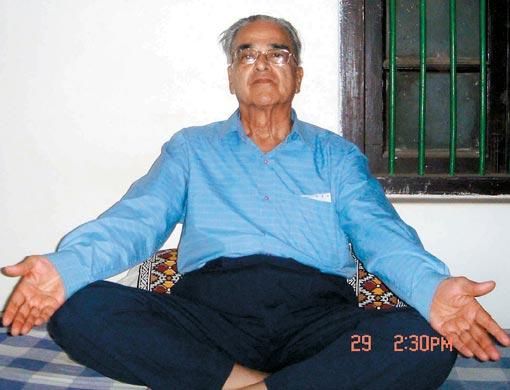Dr Padmakar Vartak, 74, claims to have visited Jupiter, Mars and Saturn. 'I've even seen an alien who was deep in thought,' the yoginaut tells Shrikant Rao.
The rat-a-tat of wedding drums and the burst of firecrackers outside the window jolts him. Then follows the nerve-jangling trrrrrring of the telephone. Padmakar Vishnu Vartak appears a trifle irritated as he disappears into a side room to attend to the phone call.
I learn that noise pollution is a speed breaker when you are on an inter-galactic journey. "It is not possible to do [inter-galactic] trips without a lot of concentration and patience,'' says the 74-year-old, returning to his seat.
Travel? But we haven't even left the room!
Most people in Pune, India, who have heard of Vartak's self-proclaimed peregrinations to distant planets do not take him seriously. But then not many anywhere in the world would. I mean, would you believe a man who claims to have set foot on Jupiter and Mars and has had a close look at Saturn ... all without leaving his drawing room? And this thanks to his yogic abilities?
The doc's fascination for yoga started in 1956 when he set up practice in Pune. Instead of the basics, Vartak directly moved to higher echelons of the Patanjali yoga, which he says he learnt from books. Not for him the asanas (postures) which required body contortions. His preferred method was to sit still in a relaxed pose. "The asana called stir sukha asana (or happiness from stillness) leads to equilibrium. There is no point in twisting your body. The mind can't be stable if there is pain in the knee,'' he explains.
"I delved deep into ... yoga, to find some explanation to supernatural events.''
In due course, Vartak says he began to 'see' things that were happening elsewhere ? like his daughter Kadambari getting hurt while playing at school or the funeral rites of his estranged elder brother Vasant on the banks of a river.
"My yogic skills had progressed to the stage described where the individual can be transported to another place,'' says Vartak.
More such instances apparently happened and his interest in the yonder had been sufficiently kindled for him to attempt what he had only heard of ? a yogic voyage into space.
The Americans made it easy for him with their space programme. By 1969, the world had images of Neil Armstrong and Buzz Aldrin taking the first steps on the moon. Vartak says the moon could have been the first on his space itinerary were it not for the "information overload".
"... My visit would not have added much, it never really attracted me as a destination. It was no use wasting my energy there,'' he says. Meanwhile, Vartak continued refining his yogic abilities ... till 1975 when Nasa embarked on its Viking I Mars mission. "I decided to preempt the Americans...,'' he says.
Dr Vartak claims to have made his foray into the solar system in August, 1975, a year before Viking I was slated to land on Mars. But a few days earlier, on July 23, he claims he did manage a Mars landing but decided on a repeat performance because "what I saw there was lost (in his memory). I could not remember anything of the first trip''.
Sunday, August 10, 1975.
Dr Vartak remembers it as a day with perfect weather conditions. It was 9am when he sat crosslegged on the floor in his room.
The 'blast off' was "very smooth'', says the doctor. "I found myself slipping out of the earth's gravitational zone. I could not experience velocity. There was shunyata (nothingness)."
Then he landed on Mars, he says. And how could he be so sure that it was the surface of Mars?
Vartak smiles benevolently: "Well you see, those who have yogic discipline have full knowledge about these things. [Yoga] does not allow such mistakes.
"It was sunset time on Mars. It was cold and I could feel a gentle breeze ? the way it is in the morning. I also saw rocks ... but no craters," he says.
Fifteen minutes later Vartak was back where he belonged ? 521, Shaniwar pet, Pune, India.
The man put his observations down on paper ? all 21 of them ? which he says corroborated with the results of the Viking I probe that would take place a year later. He submitted letters giving details of his voyage to everyone he thought would be interested ? the country's prime minister, president, space scientists and intellectuals ? no one has bothered to even read them.
The post-Martian disappointment did not deter Dr Vartak from aiming for other realms. His next destination was Jupiter and on August 27, 1977, he 'set off'.
"[On Jupiter], there were thick purple clouds in the sky which gave an impression of a churning motion. I saw three full moons ... I also found a belt of rocks ...the environment was not beautiful and it made me morose ...''
Once again back on terra firma, he put down 18 points of observation.
Again he says he was 'proved right' when the American Voyager started beaming down information about Jupiter. "It was the triumph of the spirit," he says. More recently, in 2004, he says he has added Saturn to the list of planets he has toured.
Incidentally, Vartak has also visited another solar system where he saw a fully-clothed gent with human-like features and a perfect body. But no conversation could be exchanged because the man was "busy contemplating something''.
"Scientists [say] it takes four light years to reach the nearest star. Yoga took me there in a matter of minutes," he says proudly.
Can such skills be developed? "Yes, but it is not easy. I took 18 years to acquire mastery. Nothing can come without belief and discipline," he says, his eyes acquiring a glazed look, perhaps contemplating new planets to visit.
The yoginaut knows no rest. There are other worlds to conquer.
If only the firecrackers outside would let leave him in peace. It's no good beginning a journey when it's so noisy outside.












